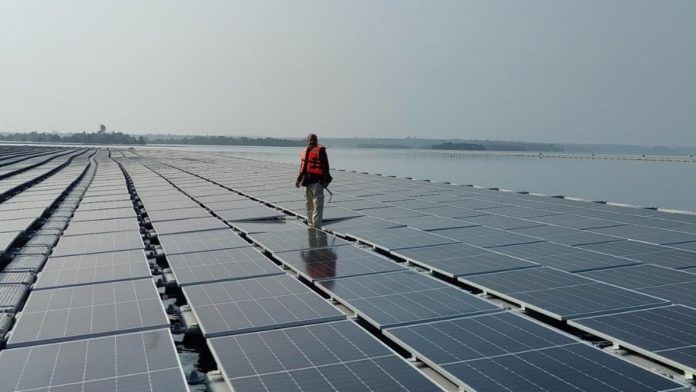New Delhi: India will need at least 600 GW of non-fossil energy capacity by 2030, higher than the government’s current target of 500 GW, to stay ahead of rising electricity demand driven by cooling needs, urban expansion, and the rapid growth of data centres, a Delhi-based thinktank said in a new report.
The assessment by the Council on Energy, Environment and Water (CEEW) draws on a projection by the Central Electricity Authority, which estimates that electricity demand would grow 5.8 per cent annually from 2022 to 2030. The report considers this to be true for a moderate demand scenario, but India’s demand for energy is expected to grow substantially more. To prevent future shortages, reduce procurement costs and keep emissions in check, CEEW recommends building an additional 100 GW of non-fossil capacity on top of India’s official target within the next five years.
The report argues that reaching 600 GW of non-fossil capacity by 2030 would yield three major gains: save approximately Rs 42,400 crore in annual power procurement costs, create 2.4 lakh jobs, and reduce emissions by roughly 16 per cent compared to FY24 levels.
But the timeline is unforgiving, and a scale like this ensures inevitable trade-offs.
“To meet its 2030 target, India will need to find space for renewables in deserts and croplands, on rooftops, and in policies, in just five years,” the report notes.
The challenges
Reaching India’s long-term net-zero target by 2070 will require 7,000 GW of solar and wind capacity, far greater than the roughly 180 GW currently installed.
In reality, deploying such renewable energy, even beyond 300 GW, requires making serious tradeoffs such as real estate which entails deploying facilities on expensive and densely populated land.
Decarbonising India’s heavy industries would require significant funding – almost $600 billion – and the adoption of sustainable technologies like carbon capture.
Complicating matters further, clean-tech supply chains for wind and solar are heavily concentrated in the hands of a few countries. Critical minerals like lithium and cobalt are also cornered. Climate finance is directed overwhelmingly to developed nations, even if emerging economies are going to form 80 per cent of future energy demand.
Just adding renewable capacity isn’t going to meet India’s climate change objectives. Heavy industries like steel and cement have annual carbon emissions in excess of 500 million tons. This is why India’s National Green Hydrogen Mission targets 5 MTPA by 2030. Six states — Gujarat, Maharashtra, Tamil Nadu, Andhra Pradesh, Odisha, and Uttar Pradesh — could provide 90 per cent of this output. Thereby positioning India as an export and manufacturing hub.
The announcement of the National Nuclear Mission in 2025 came with the aim to scale the current nuclear power capacity from less than 10GW up to 100GW by 2047.
Also read: India set to be world’s hungriest energy market by 2035, says IEA report
Where is India now?
According to the International Energy Agency (IEA), India has been installing renewables at the fastest rate among major economies. Since 2008-10, India has added roughly 100 GW of solar and 40 GW of wind capacity. Including other renewable sources like hydrogen, nuclear, etc., it produces almost 250 GW of renewable energy. Collectively, non-fossil sources now account for more than 50 per cent of India’s installed capacity. India’s ‘double leapfrog’ increases clean energy deployment while bringing electricity access to its people.
Between 2005-2020, India reduced its emissions intensity of GDP by 36 per cent. From 2017, it has brought electrification to 98 per cent of all households. It has also expanded cleaner cooking fuel LPG’s access to over 70 per cent of homes. The Unnat Jyoti by Affordable LEDs for All (UJALA) scheme brought down the price of a single light bulb by 85 per cent between 2015 and 2019. This made India the largest procurer of LED light bulbs.
Clean energy is now very much part of the rural economy. Decentralised Renewable Energy (DRE) technologies like solar dryers, mini cold storages, micro-pumps draw power from renewables like the sun or biomass. They help farmers do, earn and save more. According to CEEW’s estimates, these technologies could support 37 million livelihoods and create a $50 billion market.
Transport is changing too. India sold nearly two million electric vehicles in 2024–25, 94 per cent of which were two-wheelers and three-wheelers.
The plurilateral world
It’s been 10 years since COP21, when a multilateral world signed the Paris Agreement, and India is attempting to reshape the global conversation. It is a party to the International Solar Alliance, the Coalition for Disaster Resilient Infrastructure, and the Global Biofuels Alliance platforms that bring together countries in the Global South. As developed countries retreat into their corners, this “plurilateral” model is a practical alternative.
India’s success would offer a blueprint for the global South to grow without repeating the West’s carbon-fueled path to development.
Johan Jose is a TPSJ alumnus currently interning with ThePrint.
(Edited by Saptak Datta)






